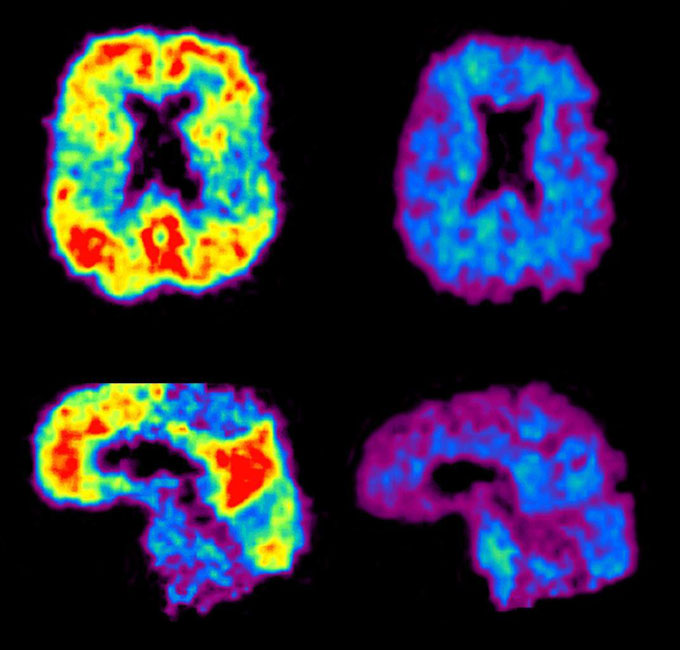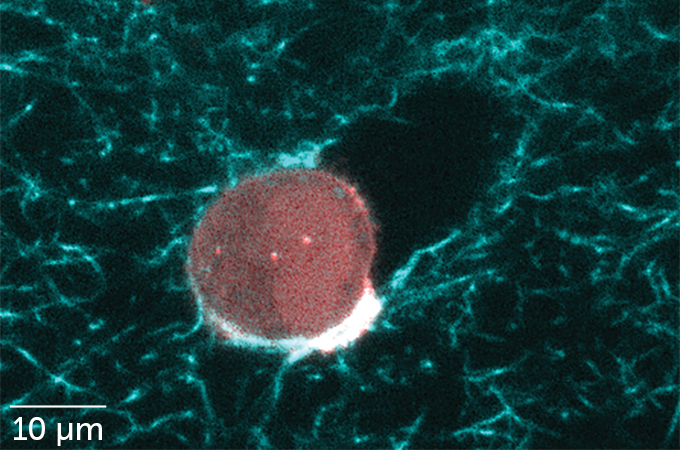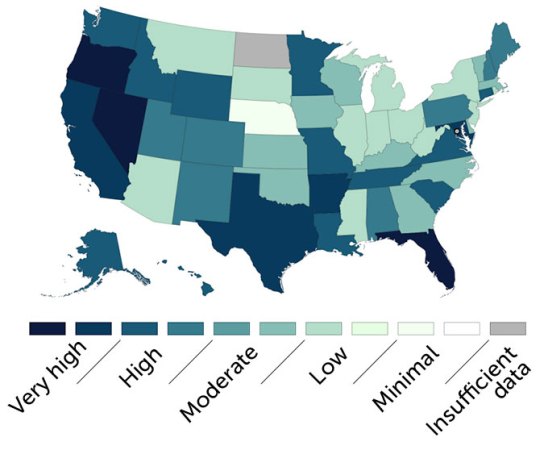Alzheimer’s disease is hard to diagnose. But proteins in the blood might provide clarity.
A series of recent findings, presented at the annual Alzheimer’s Association International Conference in Philadelphia and in research papers, raise the possibility of a simple blood draw to help doctors figure out if a person’s cognitive problems are caused by Alzheimer’s — or something else.
Decades ago, the only definitive way to get a diagnosis was an autopsy. Since then, scientists have figured out how to see the disease in living people. Spinal taps reveal levels of key proteins associated with the disease. And brain scans can illuminate the characteristic plaques and tangles that mar the brain in a person with Alzheimer’s disease.
But spinal taps and brain scans are expensive and uncomfortable. A blood draw would lower barriers to diagnosis even further. That matters, because while Alzheimer’s has no cure, an easier, faster way to spot the disease could give people more time to discuss therapy options, including the newly available drugs that lower levels of amyloid, the sticky protein that accumulates in the brain in Alzheimer’s (SN: 7/17/23). Those drugs moderately slow the progression of the disease, but they come with serious side effects (SN: 6/7/21).
“It’s an exciting moment,” says neuropathologist Eliezer Masliah of the National Institute on Aging in Bethesda, Md. “It’s an explosive moment,” one that has the potential to help reshape the diagnosis and treatment of the nearly 7 million people with Alzheimer’s in the United States, and millions more worldwide, he says.
Still, lots of questions surround these new blood tests, Masliah cautions. Such tests are available now, but none are approved by the U.S. Food and Drug Administration. And their usefulness for testing people before any symptoms appear is being studied. “We’re at an early stage right now.” If past Alzheimer’s research is any indication, the answers won’t be simple or quick.
For now, it’s clear that the landscape is changing quickly, and scientists and doctors are bound to learn more about this disease as blood tests for Alzheimer’s disease get more attention. Here’s what we know about the tests so far.
Do blood tests for Alzheimer’s work better than current ways to diagnose the disease?
Without specialized brain scans or cerebrospinal fluid tests, doctors aren’t so great at diagnosing Alzheimer’s disease. A study of 1,213 people in Sweden found that primary care doctors were correct — at both identifying Alzheimer’s and ruling it out — only 61 percent of the time. Those results were presented at the Philadelphia AAIC meeting July 28 and published the same day in JAMA.
“It’s not that we think primary care physicians do not do a good job. They do,” says Oskar Hansson, a dementia researcher and neurologist at Lund University and Skåne University Hospital in Malmö, Sweden. “It’s that the tools they have today are not good enough.” Even dementia specialists didn’t do a whole lot better: They were right 73 percent of the time.
But a blood test could help get that accuracy up. In Hansson and colleagues’ recent study, a blood test that measured two ratios of Alzheimer’s-related proteins (versions of amyloid and tau) in people’s blood was 91 percent accurate. That’s a big difference from the doctors’ accuracy, when even the specialists were misdiagnosing about 1 out of 4 patients.

The results are important because they address how a blood test works in a real-world setting, says neurologist and Alzheimer’s researcher Stephen Salloway of Warren Alpert Medical School of Brown University in Providence, R.I. “This is one of the first studies evaluating this test in primary care,” he says.
The results also hold promise for getting people a diagnosis much more quickly. Right now, a person who goes to their doctor with memory or thinking problems can spend months or even years waiting for appointments and tests that yield an Alzheimer’s diagnosis. By the time they are diagnosed, their symptoms may be too advanced to benefit from new treatments, says JAMA study coauthor Suzanne Schindler, a neurologist and dementia specialist at Washington University School of Medicine in St. Louis. “We see this all the time … they’ve gotten to us too late.”
What exactly do these blood tests measure?
There are lots of potential markers for Alzheimer’s disease that circulate in blood. And scientists are studying many of them (SN: 2/1/18). But one particular marker has garnered lots of attention lately: a protein called p-tau217. “I think it’s fairly settled now that p-tau217 is really an exquisite biomarker of amyloid plaques,” Schindler says.
Tau is a protein that has long been known to form tangles in the brains of people with Alzheimer’s. Like any protein, tau is made of a string of amino acids, some of which can be decorated with chemical tags. That “p” in p-tau217 means that one of the amino acids in the tau protein (the 217th, in fact) is decorated with a phosphate group — a modification called phosphorylation.
Some blood tests measure the level of p-tau217 on its own. But the test used in the recent study included the ratio of p-tau217 proteins to tau that isn’t phosphorylated at spot 217. That ratio may be more accurate than measuring just one version of tau because diseases other than Alzheimer’s can affect overall tau levels, Schindler says. The test also included a ratio of two types of amyloid proteins.
These ratios in the blood indicate the amount of amyloid plaques in the brain. (The ratios also correlates well with markers of the disease in cerebrospinal fluid.)
Can Alzheimer’s blood tests stand alone? Will they be the final word on a diagnosis?
No. Blood tests provide one piece of the overall clinical picture of a person. There are lots of reasons a person might be experiencing cognitive trouble, such as drug side effects or trouble sleeping.
“I think it’s important not to attribute all symptoms to Alzheimer’s disease because someone has a positive test,” Schindler says. “I can’t cure their Alzheimer’s disease, but I can stop medications that are causing problems, or I can diagnose their sleep apnea, or I can do other things that are helpful.”
Are these tests available now?
Yes. “Certainly people are using it out there,” Masliah says.
But blood tests are not necessarily thoroughly tested for accuracy. In a head-to-head comparison of six commercially available tests, the tests that used p-tau217 accurately identified signs of Alzheimer’s disease, specifically amyloid accumulation in a PET scan, Schindler and her colleagues found. That work was described in a preprint on medRxiv.org and presented July 30 at the AAIC meeting.
No Alzheimer’s blood test is approved by the U.S. Food and Drug Administration. Salloway points out that FDA approval isn’t necessary for use, though it may inspire confidence in the results. Schindler says she wouldn’t be surprised if FDA approval were to happen next year for one or more of these tests. But it’s not clear if insurance companies or government-provided health care programs will routinely cover these tests.
What’s next for Alzheimer’s blood tests?
There are still lots of unknowns, including whether these tests work well for diverse populations across the world. “You can always do more research that can validate it even more,” says neurologist Sebastian Palmqvist of Lund University and Skåne University Hospital in Malmö, Sweden, who coauthored the JAMA paper. “In Sweden, we feel very comfortable, at least in specialist settings, to start using this test.” That may not be the case for other places and groups of people.
Another missing piece is the standardization of these tests. There are not yet guidelines that would help doctors know when to use them and how to interpret the results.
“There is a lot of data already that this would be an excellent marker,” Masliah says. “But we still need that last piece to have the actual guidelines. Without that it would be the wild west. You can interpret the results any way you want. That would not help anybody.”
Guidelines, similar to what exists for cholesterol levels, would need to be developed before these tests are widely useful, he says.
#Alzheimers #blood #tests #ways
Image Source : www.sciencenews.org



